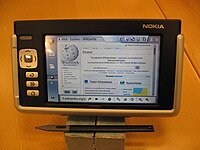| Nokia 770 Internet Tablet | |
 | |
| Manufacturer | Nokia |
|---|---|
| Type | Internet appliance |
| Connectivity | IEEE 802.11, Bluetooth |
| Retail availability | 2005-11-03 |
| Media | RS-MMC or MMCmobile |
| Operating system | Internet Tablet OS 2006, (Debian GNU/Linux - based Maemo) |
| Input | Touchscreen |
| Camera | N/A |
| Power | BP-5L Li-Polymer 1500 mAh Battery |
| CPU | 252 MHz Texas Instruments OMAP 1710 |
| Memory | 64MB Random Access Memory, 128MB Flash |
| Display | 800 × 480 resolution, 4.13 in diagonal, widescreen |
| Successor | Nokia N800 |
The Nokia 770 Internet Tablet is a wireless Internet appliance from Nokia, originally announced at the LinuxWorld Summit in New York City on May 25, 2005.[1] It is designed for wireless Internet browsing and e-mail functions and includes software such as Internet radio, an RSS news reader, image viewer and media players for selected types of media.
The device went on sale in Europe on November 3, 2005, at a suggested retail price of €349 to €369 (£245 in the United Kingdom).[2] In the United States, the device became available for purchase through Nokia USA's web site on November 14, 2005 for $359.99. On January 8, 2007, Nokia announced the Nokia N800, the successor to the 770.[3] In the summer of 2007, the price for the Nokia 770 fell to under USD 150 / EUR 150 / GBP 100. [4][5][6]
Contents |
Specifications
- Dimensions: 141×79×19 mm (5.5×3.1×0.7 in)
- Weight: 230 g (8.1 oz) with protective cover or 185 g (6.5 oz) without.
- Processor: Texas Instruments OMAP 1710 CPU running at 252 MHz. It combines the ARM architecture of the ARM926TEJ core subsystem with a Texas Instruments TMS320C55x digital signal processor.
- Memory: 64MB of DDR RAM, and 128MB of internal FLASH memory, of which about 64MB should be available to the user. Option for extended virtual memory (RS-MMC up to 1 GB (2GB after flash upgrade))
- Display and resolution: 4.1 inches, 800×480 pixels at 225 pixels per inch with up to 65,536 colors
- Connectivity: WLAN (IEEE 802.11b/g), Bluetooth 1.2, dial-up access, USB (both user-mode, and non powered host-mode)
- Expansion: RS-MMC (both RS-MMC and DV-RS-MMC cards are supported).
- Audio: speaker and a microphone
This device is manufactured in Estonia and in Germany.
Software
The operating system is a modified version of Debian GNU/Linux (running Linux 2.6.12), including an X Window System-based graphical user interface in the form of a window manager incorporating the GTK+ toolkit and Hildon user interface widgets. BusyBox replaces many common Linux system utilities. The device includes a PDF viewer and the Opera Web browser, along with a media player application. These allow it to process the following media file formats:
- Audio: MP3, RealAudio, MPEG-4, AAC, WAV, AMP, MP2
- Image: JPEG, GIF, BMP, TIFF, PNG, Animated GIF, SVG Tiny, ICO
- Video: MPEG-1, MPEG-4, RealVideo, H.263, AVI, 3GP
The development platform for the Nokia 770 is known as Maemo.
Internet Tablet OS 2006 edition
On May 16, 2006 Nokia announced a new version of the Internet Tablet operating system which includes major improvements in response to user requests.[7]
Most notable of these improvements include a thumb-driven on-screen keyboard for fast text input and Jabber-based Voice over IP and instant messaging software. The VoIP software is compatible with Google Talk. Also included was the ability to support 2Gb RS-MMC cards (formatted FAT). This upgrade is the default OS shipped on new 770 Internet Tablets and became available as a downloadable upgrade for existing users on June 30, 2006. The Linux kernel was upgraded to 2.6.16 with the associated patches for the OMAP platform. This new version uses kernel preemption for improved interactivity.
On June 9, 2006 Nokia released a beta version of the development platform aimed at developers porting their programs to Internet Tablet 2006 Edition (shortened to IT2006). End users were advised to remain with the April IT2005 edition until IT2006 was officially released. Some of the final features in IT2006 were not yet present in the beta, such as multi-protocol messaging.[8]
The full release version of the Internet Tablet OS 2006 edition was posted by Nokia on June 30, 2006.[9]
An update to IT 2006 came out in November 2006. This adds support for 2 GB RS-MMC cards and also adds Wikipedia as a searchable resource on the Home Page Search Applet and many more enhancements.[10]
Accessories
In October 2006, Nokia released the Navigation Kit for Nokia 770 Internet Tablet. It includes a Bluetooth-based Nokia LD-3W GPS receiver, navigation software from Navicore with maps of Europe, a memory card, a car holder and a car charger.
Versatility
Because of the Linux based operating system and the open-source contributions from Nokia, the Nokia 770 Internet Tablet has a great appeal to the hacker and DIY markets. Programmers are porting applications to the Maemo platform allowing a much more rapidly growing application catalog than other mobile platforms would enjoy.[11] The inclusion of WiFi, Bluetooth, and USB host functionality (through a hack) permits enthusiasts to expand their tablets to include USB mass storage, Bluetooth GPS receivers, a normal USB keyboard, or other devices.

















0 comments:
Post a Comment
Please your comment here!